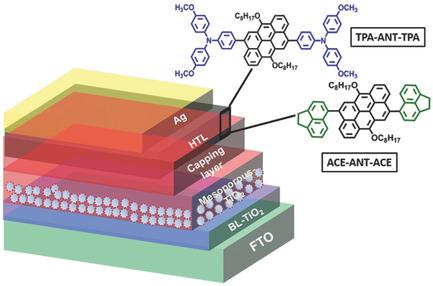当前位置:
X-MOL 学术
›
Adv. Energy Mater.
›
论文详情
Our official English website, www.x-mol.net, welcomes your
feedback! (Note: you will need to create a separate account there.)
Molecular Engineering Using an Anthanthrone Dye for Low‐Cost Hole Transport Materials: A Strategy for Dopant‐Free, High‐Efficiency, and Stable Perovskite Solar Cells
Advanced Energy Materials ( IF 24.4 ) Pub Date : 2018-02-19 , DOI: 10.1002/aenm.201703007 Hong Duc Pham 1 , Thu Trang Do 1 , Jinhyun Kim 2 , Cecile Charbonneau 3 , Sergei Manzhos 4 , Krishna Feron 5, 6 , Wing Chung Tsoi 3 , James R. Durrant 2, 3 , Sagar M. Jain 3 , Prashant Sonar 1
Advanced Energy Materials ( IF 24.4 ) Pub Date : 2018-02-19 , DOI: 10.1002/aenm.201703007 Hong Duc Pham 1 , Thu Trang Do 1 , Jinhyun Kim 2 , Cecile Charbonneau 3 , Sergei Manzhos 4 , Krishna Feron 5, 6 , Wing Chung Tsoi 3 , James R. Durrant 2, 3 , Sagar M. Jain 3 , Prashant Sonar 1
Affiliation

|
In this report, highly efficient and humidity‐resistant perovskite solar cells (PSCs) using two new small molecule hole transporting materials (HTM) made from a cost‐effective precursor anthanthrone (ANT) dye, namely, 4,10‐bis(1,2‐dihydroacenaphthylen‐5‐yl)‐6,12‐bis(octyloxy)‐6,12‐dihydronaphtho[7,8,1,2,3‐nopqr]tetraphene (ACE‐ANT‐ACE) and 4,4′‐(6,12‐bis(octyloxy)‐6,12‐dihydronaphtho[7,8,1,2,3‐nopqr]tetraphene‐4,10‐diyl)bis(N,N‐bis(4‐methoxyphenyl)aniline) (TPA‐ANT‐TPA) are presented. The newly developed HTMs are systematically compared with the conventional 2,2′,7,7′‐tetrakis(N,N′‐di‐p‐methoxyphenylamino)‐9,9′‐spirbiuorene (Spiro‐OMeTAD). ACE‐ANT‐ACE and TPA‐ANT‐TPA are used as a dopant‐free HTM in mesoscopic TiO2/CH3NH3PbI3/HTM solid‐state PSCs, and the performance as well as stability are compared with Spiro‐OMeTAD‐based PSCs. After extensive optimization of the metal oxide scaffold and device processing conditions, dopant‐free novel TPA‐ANT‐TPA HTM‐based PSC devices achieve a maximum power conversion efficiency (PCE) of 17.5% with negligible hysteresis. An impressive current of 21 mA cm−2 is also confirmed from photocurrent density with a higher fill factor of 0.79. The obtained PCE of 17.5% utilizing TPA‐ANT‐TPA is higher performance than the devices prepared using doped Spiro‐OMeTAD (16.8%) as hole transport layer at 1 sun condition. It is found that doping of LiTFSI salt increases hygroscopic characteristics in Spiro‐OMeTAD; this leads to the fast degradation of solar cells. While, solar cells prepared using undoped TPA‐ANT‐TPA show dewetting and improved stability. Additionally, the new HTMs form a fully homogeneous and completely covering thin film on the surface of the active light absorbing perovskite layers that acts as a protective coating for underlying perovskite films. This breakthrough paves the way for development of new inexpensive, more stable, and highly efficient ANT core based lower cost HTMs for cost‐effective, conventional, and printable PSCs.
中文翻译:

使用蒽醌染料进行低成本空穴传输材料的分子工程:无掺杂,高效且稳定的钙钛矿太阳能电池的策略
在本报告中,使用了两种新型小分子空穴传输材料(HTM)的高效,防潮钙钛矿太阳能电池(PSC),该材料由经济高效的前蒽酮(ANT)染料制成,即4,10-bis(1, 2-二氢ac萘-5-基)-6,12-双(辛氧基)-6,12-二氢萘[7,8,1,2,3- nopqr ]四苯(ACE-ANT-ACE)和4,4'- (6,12-双(辛氧基)-6,12-二氢萘并[7,8,1,2,3- nopqr ]四苯酚-4,10-二基)双(N,N-双(4-甲氧基苯基)苯胺) (TPA‐ANT‐TPA)出现了。新开发的HTMS被系统与传统的2,2',7,7'-四(相比Ñ,Ñ ' -二p-甲氧基苯基氨基)-9,9'-螺二茂烯(Spiro-OMeTAD)。ACE‐ANT‐ACE和TPA‐ANT‐TPA用作介观TiO 2 / CH 3 NH 3 PbI 3 / HTM固态PSC中的无掺杂HTM ,并将性能和稳定性与Spiro-OMeTAD进行了比较基于PSC。在对金属氧化物支架和器件处理条件进行了广泛的优化之后,基于TPA‐ANT‐TPA HTM的新型无掺杂剂PSC器件实现了17.5%的最大功率转换效率(PCE),而磁滞却可以忽略不计。21 mA cm -2的惊人电流还可以从光电流密度更高的填充因子0.79确认。在1种阳光条件下,使用TPA-ANT-TPA获得的PCE为17.5%,比使用掺杂Spiro-OMeTAD(16.8%)作为空穴传输层制备的器件要高。研究发现,掺杂LiTFSI盐可提高Spiro-OMeTAD的吸湿性。这导致太阳能电池的快速降解。同时,使用未掺杂的TPA-ANT-TPA制备的太阳能电池表现出去湿性并提高了稳定性。此外,新的HTM在活性光吸收钙钛矿层的表面上形成了完全均匀且完全覆盖的薄膜,可作为基础钙钛矿膜的保护层。这一突破为基于成本效益,
更新日期:2018-02-19
中文翻译:

使用蒽醌染料进行低成本空穴传输材料的分子工程:无掺杂,高效且稳定的钙钛矿太阳能电池的策略
在本报告中,使用了两种新型小分子空穴传输材料(HTM)的高效,防潮钙钛矿太阳能电池(PSC),该材料由经济高效的前蒽酮(ANT)染料制成,即4,10-bis(1, 2-二氢ac萘-5-基)-6,12-双(辛氧基)-6,12-二氢萘[7,8,1,2,3- nopqr ]四苯(ACE-ANT-ACE)和4,4'- (6,12-双(辛氧基)-6,12-二氢萘并[7,8,1,2,3- nopqr ]四苯酚-4,10-二基)双(N,N-双(4-甲氧基苯基)苯胺) (TPA‐ANT‐TPA)出现了。新开发的HTMS被系统与传统的2,2',7,7'-四(相比Ñ,Ñ ' -二p-甲氧基苯基氨基)-9,9'-螺二茂烯(Spiro-OMeTAD)。ACE‐ANT‐ACE和TPA‐ANT‐TPA用作介观TiO 2 / CH 3 NH 3 PbI 3 / HTM固态PSC中的无掺杂HTM ,并将性能和稳定性与Spiro-OMeTAD进行了比较基于PSC。在对金属氧化物支架和器件处理条件进行了广泛的优化之后,基于TPA‐ANT‐TPA HTM的新型无掺杂剂PSC器件实现了17.5%的最大功率转换效率(PCE),而磁滞却可以忽略不计。21 mA cm -2的惊人电流还可以从光电流密度更高的填充因子0.79确认。在1种阳光条件下,使用TPA-ANT-TPA获得的PCE为17.5%,比使用掺杂Spiro-OMeTAD(16.8%)作为空穴传输层制备的器件要高。研究发现,掺杂LiTFSI盐可提高Spiro-OMeTAD的吸湿性。这导致太阳能电池的快速降解。同时,使用未掺杂的TPA-ANT-TPA制备的太阳能电池表现出去湿性并提高了稳定性。此外,新的HTM在活性光吸收钙钛矿层的表面上形成了完全均匀且完全覆盖的薄膜,可作为基础钙钛矿膜的保护层。这一突破为基于成本效益,











































 京公网安备 11010802027423号
京公网安备 11010802027423号